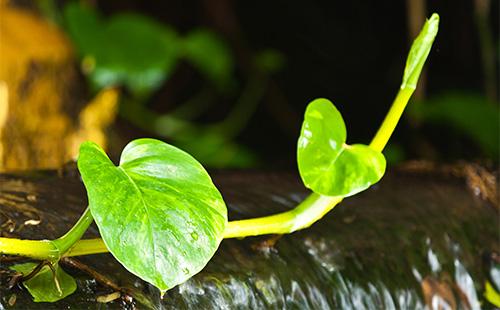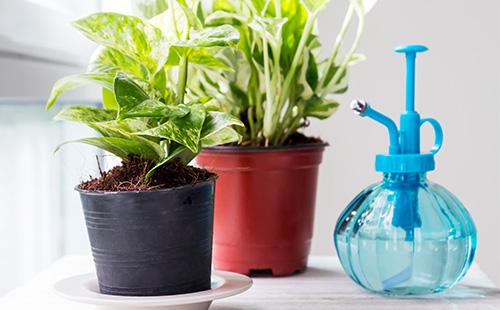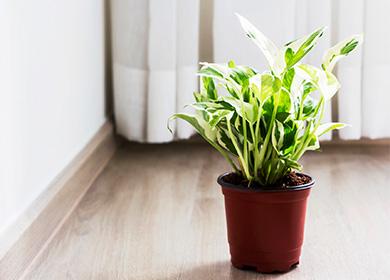The content of the article
Scindapsus (Scindapsus) from the Aroid family. His homeland is Southeast Asia. The plant has chosen tropical forests. In vivo, this is a powerful semi-epiphyte vine. Exot settles near large trees, then to climb their trunks. So the liana can stretch up to 15 m.
In nature, a climbing plant blooms annually. Its inflorescences are small, in shape resemble a corn cob, around which there is a mantle. The "domesticated" scindapsus is a decorative leafy "climbing" plant. Beautiful, but not blooming. It is almost impossible to achieve flowering on the windowsill, so a tropical guest is grown for the sake of luxurious leathery sheets. They appreciate “damn ivy” both for fast-growing stems and for the fact that he is extremely “naughty” - an ideal “friend” for inexperienced gardeners. In Sri Lanka, scindapsus is considered a weed. The plant occupies vast territories. They are actively fighting with him, because the liana violates the ecology of the region.
Views for the home
There are about 25 species of scindapsus. However, of these, only three are "domesticated." All varieties for the windowsill are unpretentious in care, so you can choose a "pet", guided by personal aesthetic perception. Indoor varieties and their distinctive features are presented in the table.
Table - Varieties of scindapsus for the house and their features
| Variety | Features |
|---|---|
| Golden | - The leaves are bright green with yellow blotches in the form of "strokes", "spray"; - many varieties |
| Spotted | - Large silver-green leaves; - increased stamina |
| Painted | - Oval large leaves; - on a dark green canvas, distinct silver-plated stains or white-blue spots; - stems are covered with warts with age |
Basic care
Plants that migrated from the tropics to the windowsill are usually moody. However, this does not apply to scindapsus: it surprises with its ability to adapt to any microclimate. The flower is suitable for those who love indoor plants, but do not find time to take care of them. To see the legendary rapid growth of creepers, you need to follow five simple rules.
Choose a place
North and west windows - it’s better not to find a place for a tropical guest. If there is an opportunity to put a flowerpot only on the east window, then you need to shade the flower in the morning, when the sun shines brightly. The southern windows of the creeper are not suitable: if this is the only possible window placement option, it is better to place the "pet" in the back of the room.
Scindapsus belongs to shade-loving plants, because in nature the liana is shaded by a tree. Ideally, you need to create diffused light.Direct sun rays are strictly contraindicated: from them burns appear on the leaves of an overseas handsome man. Variegated specimens require brighter lighting, however, they also do not like direct sun.
Adjust the temperature
The plant does not tolerate excessive heat, although it does not die from it, but simply ceases to grow actively. Moderate heat is what the scindapsus needs. In spring and summer, it is necessary to maintain the temperature in the room within + 20-25 ° С. From the end of autumn, the temperature can be lowered. In winter, the vines are kept in a cool room, but make sure that the thermometer does not fall below + 16 ° C.
Water correctly
The pet does not need frequent watering: between moisturizations, the soil needs to dry out to a third of its depth, otherwise the roots will rot. At a moderate temperature, water the plant enough once a week, if the room is hot - more often. With the onset of cold weather, the procedure is minimized. Water must be taken at room temperature. Pre defend it.
Create the right humidity
Humidity is what you need to pay special attention to when growing scindapsus. An unpretentious tropical guest may suddenly start to be “capricious” if the air is too dry.
High humidity is the key to the rapid growth of creepers. It is necessary to spray twice a day, regularly wipe the leaves of the flower with a damp rag, arrange the vines "shower". Next to the flowerpot, place the containers with water, pour expanded clay into the pan and wet it.
“Feed” on schedule
In the spring and summer months, scindapsus needs additional nutrition. Buy fertilizer designed to nourish deciduous plants, but back out of the instructions: apply half of this dose every two weeks. With the onset of cold weather, the frequency of "feeding" is reduced - fed monthly, but once, and if the wintering regimen is observed, then they feed even less often - after two months.

Transfer
In order for the scindapsus to grow actively, it needs to be transplanted regularly. “Resettlement” of young specimens is carried out annually. An adult vine is disturbed once every three years. If you are lazy and skip transplants, the probability of getting a weakened plant increases. This is due to the fact that the soil is compacted over time - oxygen ceases to flow to the roots. Especially if you do not periodically loosen the earth. To transplant the creeper "out of turn" should, if there is a suspicion that the roots began to rot. To make the plant comfortable in the new "house", you need to know some subtleties.
- Choose the time. The start of active plant growth is the best time to transplant. This period falls on the end of February - March: plan a “relocation” for these months.
- We pick up the pot. It is better to take a flowerpot shallow, but wide. So you can plant new sprouts to the plant, thereby creating a lush bush. Check for holes at the bottom of the tank: stagnation of water is dangerous for exotics.
- We use drainage. The bottom layer in the flowerpot is necessarily drainage. Expanded clay can fulfill this role. Drainage reduces the likelihood of decay of the root system.
- We make the soil. To create a suitable soil mixture, you need to mix sheet, turf, peat, sand (all in the same amount, except for sand - its volume is half of the equal components). Do not want to bother? You can purchase a substrate. Also suitable for begonias, violets, palm trees - the scindapus is not picky about the soil.
Transplant the plant carefully: do not damage the shoots. Before “moving” the liana to a new container, carefully inspect the roots. If there are damaged, dry or rotten parts, they must be removed. The tool with which you plan to cut the roots, you must first wipe with alcohol.
Immediately after the “relocation”, water moderately, do not feed the first month. Then proceed according to the same scenario as before.
Formation
Scindapsus grows very quickly: over a year the shoots can stretch 40 cm. If you do not want to see the “jungle” on the windowsill one morning, you need to cut the plant. This is best done immediately after transplantation, and then as necessary. Regular procedure allows you to keep the flower "in shape". Trimming is carried out with a sterile instrument. It is advisable to treat the cut with charcoal.
Do you want to grow exotic as a lush bush? Nothing is impossible! You just need to pinch the shoots. So you can form a beautiful crown: after the procedure, the flower ceases to grow in length and spends all its efforts on the development of existing sheets and on branching. As a result, a lush bush with luxurious leaves flaunts on the windowsill.
Most often, scindapsus is grown in the form of creeping creepers. To form a creeping plant, support should be used. They are instilled during planting / transplantation. Young specimens are made of wire arches or put purchased plastic stairs.
Adult plants are large, the wire arch may not stand. They are offered plastic tubes as a support. Florists are advised to take special tubes with holes. The tube must be filled with moistened sphagnum, and the aerial roots of the plant should be missed into the holes. So the liana will receive additional moisture, which means it will grow even more actively.
Breeding
Scindapsus becomes unattractive with age: the main stem is exposed at the base. To always have a young beautiful vine growing in the house, it is recommended to grow a new flower every three years. Since at home the plant does not bloom, and it is extremely difficult to get the seeds, you need to propagate it with cuttings. Do this in four steps.
- Chop the cuttings. Be sure to cut it under the knot - there roots form. You can combine reproduction with pruning. It is better to take apical cuttings: those on which are from three leaves are suitable.
- Prepare the soil. Mix sand and moss in a 1: 1 ratio (sand can be replaced with peat). Plant the cuttings in the resulting mixture.
- Create a Greenhouse. Cover the cuttings with polyethylene or “put on” a jar. Sprouts will take root, if high humidity is maintained, make sure that the temperature does not fall below + 22 ° C.
- Transplant. When the seedlings grow roots (it takes about three weeks), you can do transplantation in a permanent soil. Sprouts can be planted in different flowerpots or transplanted into a single pot to grow a lush bush.
“Young growth” obtained from cuttings should be regularly watered. It is important to find a “middle ground”: not to overflow, but not to overdry. After two months of living in constant soil, the liana is ready to “feed”: choose the right nourishment for it.
Growing problems
Diseases are not afraid of scindapsus. Florists love a tropical guest, not only for his not pickiness, but also for resistance to ailments. However, the liana may lose all its beauty due to the banal mistakes made by the owner. It is impossible to fully insure against insect damage. The sooner the problem is exposed, the reason for its occurrence is found and competent treatment is carried out, the higher the likelihood that the “pet” will be saved.If time is lost, but there are intact tops - cut them off, start growing a new plant.
Florist Errors
Scindpusus is undemanding and after "domestication" has learned to adapt, but the cultivation of any plant requires compliance with certain rules, even minimal ones. Negligence, care gaps - the most common reason why the "pet" begins to wither, looks weakened. The problems that the grower may encounter in the process of growing vines, and their causes are listed in the table.
Table - Floriculture mistakes when growing scindapsus
| Problem | Cause |
|---|---|
| Leaves turn yellow and fall | - deficiency of nutrients; - draft |
| Green foliage pales | Oversupply of the sun |
| Foliage loses its variegation | Lack of light |
| Leaves curl, dry at the tips | - lack of moisture; - dry air; - neighborhood with a radiator |
| Black spots appear on the leaves, then they fall off | - Waterlogging of the soil; - root decay |
| Rotting stems | Overflow combined with low temperature |
Most problems are resolved by eliminating the root cause. The most difficult thing to save is a plant whose roots have undergone a process of decay. You can’t do without a transplant. If the lesion is small, then everything will work out, the main thing is to remove the decayed parts and treat the cuts with charcoal or activated carbon.

Pests
Scindapsus is rarely attacked by pests, but no one is safe from unforeseen situations. More often than others on the liana you can see such insects:
- thrips;
- shields;
- aphid;
- spider mite.
As a result of the life of insects, the plant loses its decorativeness, leaves curl up, fall off, the stems dry or become sluggish, growth and branching slows down or completely stops. The main thing is to find the enemy in time. Check your green pet regularly and you won’t miss a problem.
You can not defeat insects without the use of special drugs. For example, Actellik has established itself well. You need to add ten drops of the drug to half a liter of water, then spray the solution onto the leaves and stems using a spray bottle. With a strong infection, one treatment can not do: the procedure will need to be repeated after a week. Remember that you can spray the vine with such a solution no more than four times.
Having grown a vine on the windowsill, you get not only a beautiful plant that can transform the interior, but also a useful friend. Overseas guest leaves produce volatile. These substances kill bacteria that are in the air. Liana enriches oxygen with organic elements, so breathing in an apartment with a scindapsus is much easier. Oriental sages attribute to the plant the ability to inspire, relieve laziness, and deduce from depression. In a word, there are many advantages, at least disadvantages - you still need to look for such ideal "pets"!
Reviews
I love flowers, I have a lot of them at home, very different ones. Today I will write about the stage dapsus. Remember the apartments of the Soviet era? In many apartments in the kitchen you could see this flower.It is also called "grandmother's flower." Appearance. Its leaf shape resembles that of a linden tree. This is a perennial liana - this means that it can live for many, many years. And it has been in the same pot for several years (1-3 years). the color of the leaves is mostly green, but it can also be mottled. I bought mine from an old woman near the crossing, about 150 rubles. He was very small, and now this one.
Watering. People water the plant in different ways. The most common ordinary watering (from a watering can or bottle. The second way is to pour a basin or bath with room temperature water, just warm. We put the flower pot in for 30 minutes and the plant absorbs itself as much as necessary. Then we put it in a sink or empty bathroom and excess water comes out Water - from the well, melt snow, settled ordinary water from the tap. If it is poured, then drops appear on the tip of the plant, like after dew on the grass. He loves it when sprayed. Either use a spray or a shower with cold water.
Cache-pot.I have a cache-pot - this is a transparent container from under the packaging: salads, herring, sauerkraut. I always see the water level from a flower. If poured, then pour out excess water. The root system is small, so transplantation is rarely necessary. Reproduction. Cut off a secateurs or a knife (regular or clerical) part with leaves and put in a glass with water. After some time, roots form. After planting in a small pot of earth. Any pot: plastic or clay. I like plastic and inexpensive and if it falls, it will not break, and it’s even easier to wash.
Tvor4eskaya, https://irecommend.ru/content/stsindapsus-ukhod-gde-vzyat-vy-znali-chto-budet-esli-perelit-rastenie-neobychnoe-svoistvo-ts
Once, many years ago, this handsome man grew up at home, and I really, really liked it !!! Than? Firstly, it is unpretentious, and secondly, it can grow both in the sun (not only in direct rays), and in the shade! Which is very convenient - you can put it almost anywhere in the apartment! And thirdly, when it grows, it is a very neat and long-and-annoying vine, which I also really like! And the leaves themselves are simply beautiful! Then, something happened to him, and he disappeared from me ... It was very sorry! And for many years, I periodically recalled him, and looked for him again! Found !!! :-)
Natalych http://otzovik.com/review_3093269.html
This simple plant can be found almost everywhere. A home creeper can itself be an interior decoration or complement other floral arrangements. Liana requires minimal care: watering (not afraid of overflow), sometimes spraying and fertilizing with universal fertilizer. The leaves can also be treated with gloss, they look more shiny and the dust settles on them much less. It grows in my ordinary land from the country. Not afraid of drafts. There was an experience of placing near the battery - this did not affect the growth and appearance. For a year it adds more than a meter in growth.
SKLana, http://otzovik.com/review_1724523.html
Scindapsus - refers to the category of unpretentious plants. It can grow even on the northern windowsills. You can even say that he loves the shadow very much. Like most indoor plants, it is not very happy with the dry air heat. Nevertheless, he stretched out under my ceiling over the battery and feels good. Maybe because the hour the flowerpot is in a shaded corner. The main thing is not to fill the flower and at least once a week to pamper with spraying. It is growing fast enough. And since it is curly - as soon as you give it space and direction - he gladly rushes to grow). For example, I stretched the usual fishing line. And it looks like a flower stretches right along the wall) Very pretty. Multiply it as easy as shelling pears. At least cut the leaf, at least the top of the creeper - and put it in a glass. It quickly takes root and after transplanting is actively growing.
Oleynik, http://otzovik.com/review_747217.html

